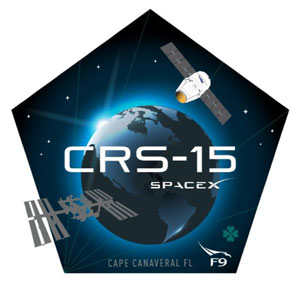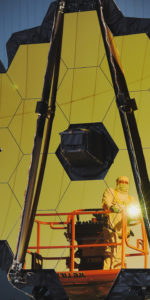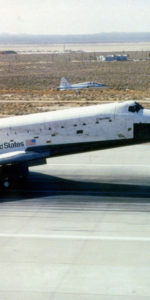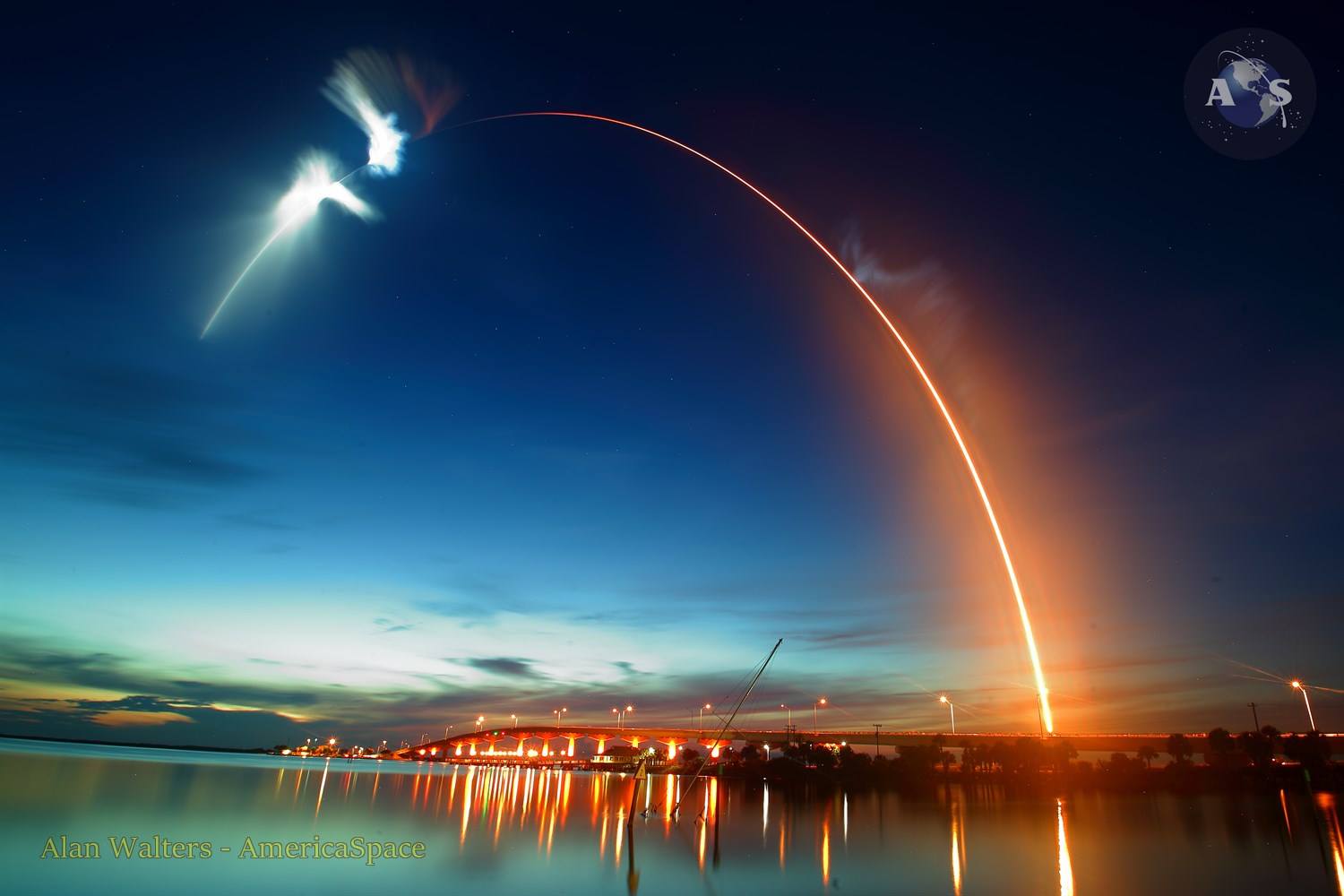
Laden with approximately 5,900 pounds of payloads and supplies for the incumbent Expedition 56 crew of the International Space Station (ISS), SpaceX’s CRS-15 Dragon cargo ship has successfully launched into low-Earth orbit from Space Launch Complex (SLC)-40 at Cape Canaveral Air Force Station, Fla. The spacecraft rose from Earth at 5:42 a.m. EDT on 29 June, beginning the 15th dedicated cargo mission under SpaceX’s Commercial Resupply Services contract with NASA. Key payloads heading uphill on this mission include NASA’s ECOsystem Spaceborne Thermal Radiometer Experiment on Space Station (ECOSTRESS), designed to monitor the temperatures and water requirements of plants, and a spare Latching End Effector (LEE) for the 57.7-foot-long (17.6-meter) Canadarm2. Current plans are for Dragon to arrive and berth at the station on 2 July, where it will remain for about a month.
SpaceX’s initial $1.9 billion CRS contract with NASA was signed way back in December 2008, and called for as many as 12 Dragon missions to deliver up to 44,000 pounds (20,000 kg) of equipment, payloads and supplies to successive ISS expedition crews. In December 2010, Dragon undertook an independent test-flight in low-Earth orbit, before a full-up “demonstration” mission in May 2012 made it the first privately-sponsored craft ever to rendezvous and berth at the station. Since then, 15 “dedicated” missions have been launched, beginning with CRS-1 in October 2012, although one of those—the unlucky CRS-7 in June 2015—was lost in a high-altitude breakup during ascent. Significant payloads have included the first of two International Docking Adapters (IDAs) for Commercial Crew operations, the Bigelow Expandable Activity Module (BEAM) and the first living creatures ever delivered to the station aboard a commercial vehicle. More recently, in January 2016, NASA selected SpaceX as one of three partners for the follow-on CRS2 contract of resupply missions, slated to occur between 2019 and the anticipated end of ISS operations in December 2024.
Aboard Dragon’s unpressurized “trunk” for CRS-15 is the 1,200-pound (550 kg) ECOsystem Spaceborne Thermal Radiometer Experiment on Space Station (ECOSTRESS), developed by NASA’s Jet Propulsion Laboratory (JPL) in Pasadena, Calif., at a cost of under $30 million. Selected in July 2014 as part of the “Earth Venture” program of small, targeted science investigations, this payload will monitor the mechanism of “transpiration”, whereby water is lost from plants through tiny pores in their leaves, as well as evaporation from the surrounding soil. When examined together, this analysis is known as “evapotranspiration”. ECOSTRESS was delivered from JPL to the Kennedy Space Center (KSC) in Florida in April of this year for final preparations and testing, ahead of launch.
“If plants do not get enough water, they show signs of stress,” explained ECOSTRESS Principal Investigator Simon Hook of JPL. “By measuring evapotranspiration, we get an early indicator of that stress and we can do something about it, before the plants collapse.”
Equipped with a Prototype Hyperspectral Infrared Imager (HyspIRI) Thermal Infrared Radiometer (PHyTIR), ECOSTRESS will provide a station-based thermometer to measure plant temperatures and total heat radiance from Earth’s surface, across the contiguous United States. In so doing, it will investigate the response of the terrestrial biosphere to changes in water availability and impacts on a global scale, seeking to understand if agricultural vulnerability can be reduced through advanced monitoring of water consumptive use and improved drought estimations. Its resolution is so fine that it will be able to measure the temperature of an individual farmer’s field. “We see in our own gardens that one type of plants needs more water to grow than the next plant, but we have not been able to see this on a global scale,” said ECOSTRESS science lead Josh Fisher of JPL. “This has huge implications for our understanding of global water and carbon cycling and which plants are going to live or die in a future world of greater droughts.”
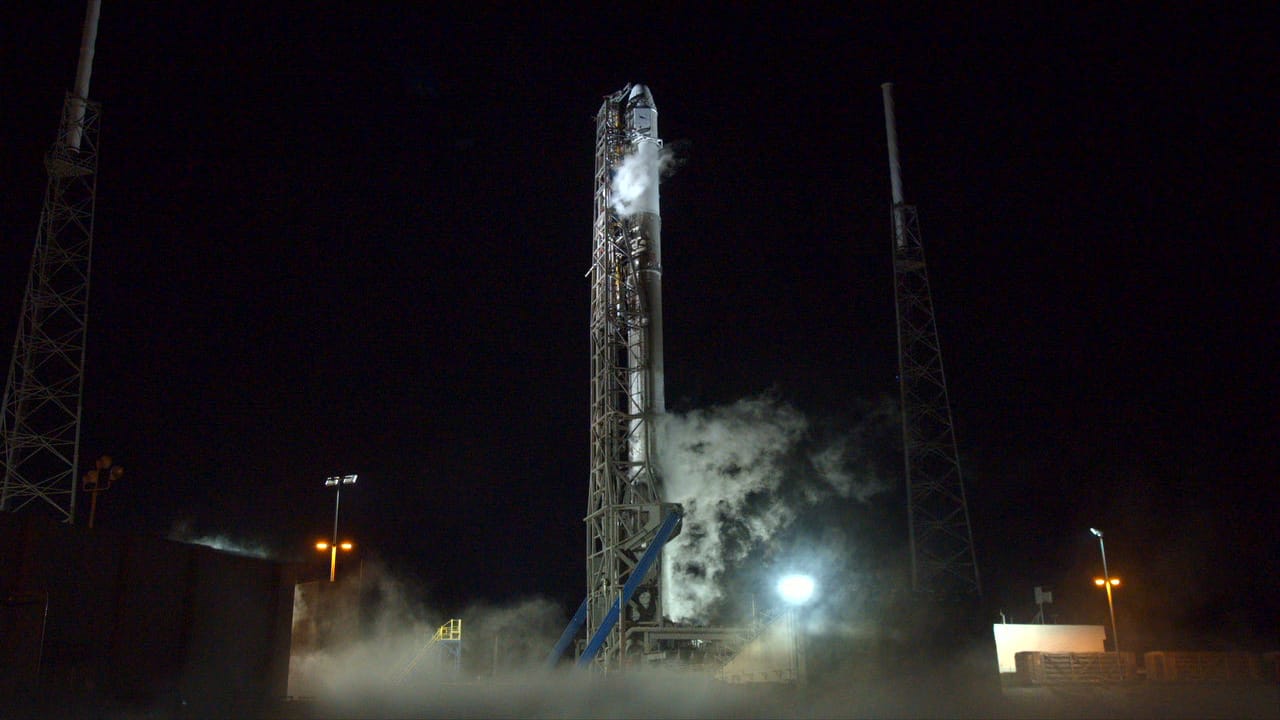
Although evapotranspiration is monitored by current Earth-circling satellites, the current data offers either high spatial resolution and low time frequency or, conversely, high time frequency against coarse resolution. ECOSTRESS offers a four-day repeating cycle of observations at a spatial resolution of 125 feet (38 meters) x 185 feet (57 meters), at an altitude sufficiently high to observe most farms and small differences within ecosystems. Moreover, the station’s orbital inclination of 51.6 degrees to the equator provides greater observation time of forests and vegetation over temperate landmasses than is possible from most polar-orbiting Earth-science satellites.
Assuming an on-time arrival of Dragon at the station, ECOSTRESS will be extracted from the spacecraft’s unpressurized trunk, via Canadarm2, controlled by the Robotics Officer (ROBO) in the Mission Control Center (MCC) at the Johnson Space Center (JSC) in Houston, Texas. It will be installed onto Site 10, at the port “end” of the Exposed Facility (EF) of Japan’s Kibo lab, where it is expected to operate for approximately one year. During a spacewalk in March, Expedition 55 astronauts Drew Feustel and Ricky Arnold installed additional wireless equipment onto the station’s Tranquility node to enhance ECOSTRESS’s payload data-processing operations.
Also riding uphill aboard CRS-15 is a “Ground Spare” Latching End Effector (LEE) for Canadarm2. Unlike the Remote Manipulator System (RMS) mechanical arm of NASA’s now-retired shuttle fleet—whose behavior mimicked the human arm in several respects—Canadarm2 has LEE “hands” at each end, which enable it to inchworm its way along the station’s expansive truss structure from worksite to worksite, plugging its Power and Data Grapple Fixtures (PDGFs) into receptacles along the way. The LEE “ends” are distinguishable by the alphabetical designations “A” and “B” and each is a cylindrical unit, about 3.5 feet (1.1 meters) long. “The LEE that will be aboard the CRS-15 Dragon mission was initially built as a Qualification Model under a development contract that delivered initial elements of Canadarm2,” the Canadian Space Agency’s Audrey Barbier told AmericaSpace. “This LEE was then converted into a flight unit under three consecutive Mobile Servicing System (MSS) Logistics and Engineering Support contracts…from 2003 to July 2016.” After delivery to the station, the new LEE will be robotically installed onto Site 8 of External Stowage Platform (ESP)-2, located on the port side of the Quest airlock.
Canadarm2 was launched to the ISS way back in April 2001 and, since then, its performance has been virtually top-notch, with the notable exception of age-induced wear-and-tear manifested through increased motor currents in its LEEs. Both ends were lubricated by spacewalking astronauts in February 2015 and January 2017, before LEE-A was replaced last October and LEE-B similarly changed-out in January of this year. The degraded LEE-A currently resides inside the station and will return to Earth later this summer aboard CRS-15 for refurbishment. “We are anticipating it will take about two years to investigate and refurbish the LEE,” Ms. Barbier told AmericaSpace. It will then be relaunched to serve as an on-orbit spare for the remainder of the ISS lifetime.
Current plans are for ECOSTRESS to be robotically extracted from Dragon’s trunk shortly after CRS-15 arrives at the station. “ECOSTRESS is removed first,” NASA’s Dan Huot told AmericaSpace. “There will be one day of setup, immediately following Dragon arrival, followed by four days to extract both ECOSTRESS and the LEE.”
Other payloads aboard Dragon’s pressurized segment included the Micro-12 cellular biology experiment, provided by NASA’s Ames Research Center (ARC) in Mountain View, Calif. It will investigate the effects of spaceflight upon the physiology of Shewanella oneidensis MR-1, an exoelectrogenic microorganism with the potential for future use in microbial fuel cells to create electricity from waste organic matter. The use of bioelectrochemical systems also has important implications for waste water processing and the synthesis of biofuels, food products and therapeutics on future long-duration space missions. Cambridge, Mass.-based biotechnology firm Angiex, Inc., has provided an experiment to test endothelial cells—which line the walls of blood vessels—as part of advanced targeted treatments for tumor cells and cardiovascular diseases.
Twenty female mice from two different strains will fly as part of the seventh Rodent Research (RR-7) payload, as part of ongoing studies by Northwestern University in Evanston, Ill., into the effect of microgravity on microorganisms in the gastrointestinal tract. These microorganisms are known to have a detrimental impact on mammalian (including human) physiology and behavior, with clear links to intestinal, immune-system, mental and metabolic health problems. And the University of Florida’s Space Algae experiment seeks to explore the genetic basis for productivity of algae cultivated in the microgravity environment. Potential uses of space-cultivated algae include carbon dioxide recycling systems, food provision for astronauts, biodiesels and chemicals for the synthesis of plastics and resins. Additionally, many algal species synthesize oils which are important for human nutrition and can protect against cosmic radiation and retinal damage.
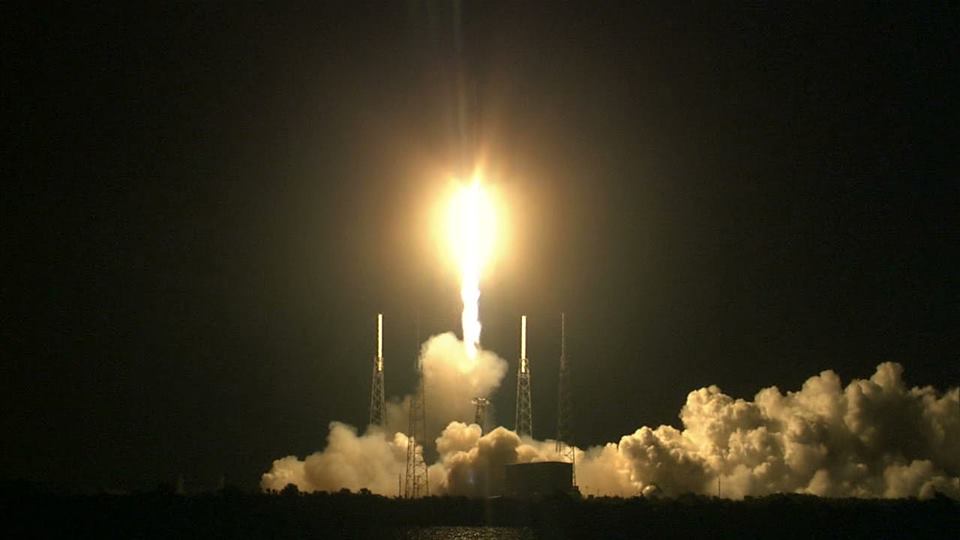
Today’s launch marks the second SpaceX launch of June and the 12th overall flight of 2018, with two missions having occurred in each month of the year to date, most recently the 4 June middle-of-the-night ascent of the heavyweight SES-12 communications satellite. Although CRS-15 is not unusual in benefiting from a reflown first stage, the B1045 element of the Upgraded Falcon 9 for this mission is significant in that it has been put through the shortest-ever launch-to-launch turnaround between its two flights. Previously used to boost NASA’s Transiting Exoplanet Survey Satellite (TESS) into space on 18 April, only ten weeks—a mere 72 days—have elapsed before its reflight. This is a substantial accomplishment over the previous record of 4.5 months, logged by the B1043 first stage which lofted the classified Zuma payload in early January and re-flew with five Iridium NEXT satellites and NASA’s Gravity Recovery and Climate Experiment Follow-On (GRACE-FO) twins in late May.
In readiness for CRS-15, the external payloads were loaded aboard Dragon’s trunk and final efforts were undertaken to install internal equipment and supplies into the pressurized cargo module. A Static Fire Test of the nine Merlin 1D+ first-stage engines of the Upgraded Falcon 9 occurred on 23 June. As is customary for ISS-bound missions, today’s T-0 was “instantaneous”, with no wiggle-room for delays in the countdown. Loading of the booster with liquid oxygen and a highly refined form of rocket-grade kerosene (known as “RP-1”) got underway an hour prior to launch. Passing T-10 minutes, the terminal countdown autosequencer was initiated and the Merlin 1D+ engines were chilled, ahead of ignition. At T-2 minutes, the Air Force Range Safety Officer declared all ground assets as “Go for Launch” and the Upgraded Falcon 9 transitioned to Internal Power and assumed primary command of all critical functions, going into “Startup” at T-1 minute. At this stage, the Niagara deluge system began flooding the pad surface with 30,000 gallons (113,500 liters) of water, per minute, to suppress the acoustic energy. The Eastern Range declared its readiness to support the launch as “Green”.
Three seconds before liftoff, the Merlins roared to life, pumping out a combined thrust of 1.5 million pounds (680,000 kg) of thrust. Liftoff occurred on-time at 5:42 a.m. EDT. Immediately after clearing the tower, the Upgraded Falcon 9 executed a combined pitch, roll and yaw program maneuver to establish itself onto the proper flight azimuth to inject the CRS-15 Dragon into orbit at an inclination of 51.6 degrees to the equator. Passing the point of maximum aerodynamic turbulence (colloquially dubbed “Max Q”) at 70 seconds into the flight, the booster later throttled back two of the Merlins to reduce the rate of acceleration at Main Engine Cutoff (MECO). Two and a half minutes after launch, the seven remaining Merlins fell silent and the first stage separated from the stack.
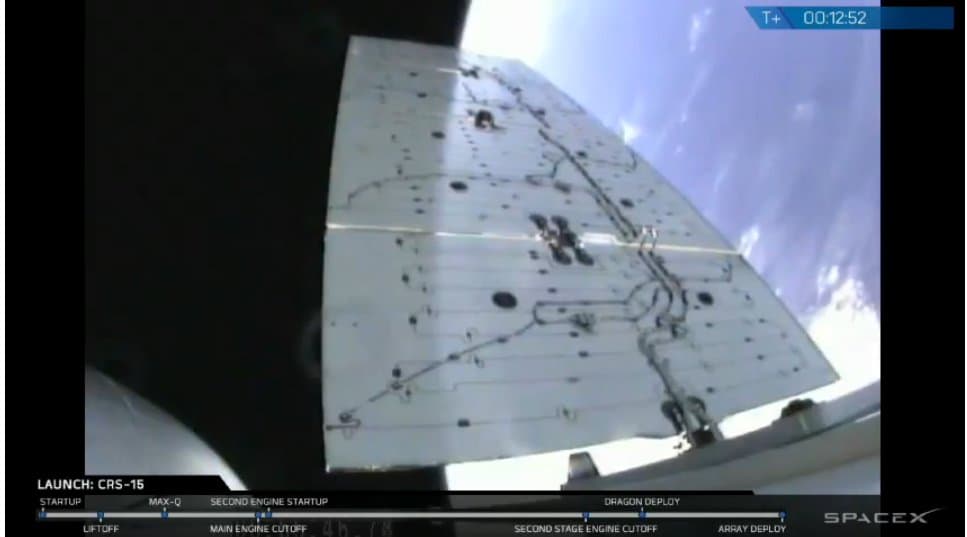
It was now the turn of the second stage, equipped with a single, restartable Merlin 1D+ Vacuum engine, capable of 210,000 pounds (92,250 kg). This now picked up the baton to deliver its payload into low-Earth orbit. During its burn, the protective nose fairing—covering Dragon’s berthing mechanism—was jettisoned and the spacecraft separated from the second stage a little under ten minutes after launch. Shortly thereafter, its pair of power-generating solar arrays were deployed. By 2.5 hours into the flight, Dragon’s Guidance and Navigation Control (GNC) Bay Door was opened to expose critical rendezvous sensors, ahead of the two-day journey to the ISS.
As with its predecessors, CRS-15 will approach the space station along the “R-Bar” (or “Earth Radius Vector”), which provides an imaginary line from Earth’s center, effectively approaching from “below”. In so doing, Dragon will take advantage of natural gravitational forces to brake its final approach and reduce the need to perform excessive numbers of thruster firings.
Capture of Dragon to the ISS is currently targeted for Monday, 2 July, with ground commanding to berth Dragon at the Earth-facing (or “nadir”) port of the Harmony node. It is expected that CRS-15 will remain attached to the space station until the end of July.
FOLLOW AmericaSpace on Facebook!
.




